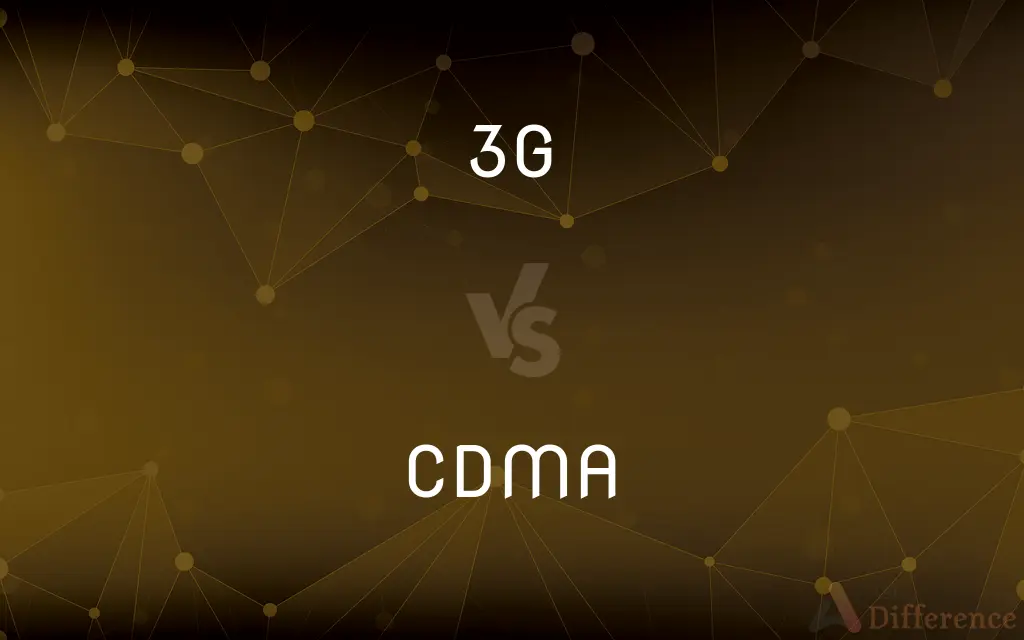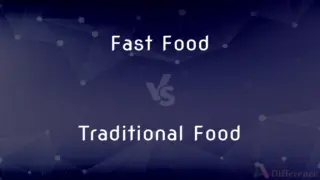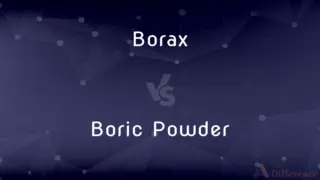3G vs. CDMA — What's the Difference?
By Tayyaba Rehman — Published on November 18, 2023
3G denotes the third generation of mobile telecommunications technology, facilitating multimedia streaming, while CDMA, Code Division Multiple Access, is a digital cellular technology that utilizes channel access methods.

Difference Between 3G and CDMA
Table of Contents
ADVERTISEMENT
Key Differences
In the context of mobile communication, 3G, or third generation, introduces significant advancements in communication technology, introducing higher data transfer rates, enabling mobile internet usage, video calling, and mobile TV. CDMA, on the other hand, focuses primarily on the methodology of channel access, introducing a technique where several transmitters can send information simultaneously over a single communication channel. Both play vital roles in enhancing mobile communication but operate on different aspects of it.
3G brings about capabilities that were not available in the earlier 2G networks. It allows for multimedia support, video conferencing, and internet browsing with greater bandwidth and lower latency. CDMA doesn't specifically pertain to these internet and multimedia advancements but rather describes a method of channel access, which can be used by various radio communication technologies, even those beyond mobile telephony. It's possible for a 3G network to use CDMA channel access methods, demonstrating that 3G and CDMA aren’t direct counterparts but can co-exist.
The underlying difference between 3G and CDMA primarily lies in their functionalities and applications in the world of mobile communication. 3G technology focuses on providing higher-speed internet connectivity, enabling seamless multimedia usage, and enhancing mobile experiences. CDMA, being a type of channel access method, regulates how cell towers and mobile devices transmit data between each other, ensuring seamless, undisrupted communication by using coded channels to prevent signals from interfering with each other.
3G, being a generation of technology, lays down the network capabilities to accommodate high-speed internet and multimedia facilities. It symbolizes an era where mobile technology took a gigantic leap in providing superior internet access, enabling functionalities that cater to contemporary mobile usage. CDMA, while not defining the capabilities of a network in the same way 3G does, orchestrates the means by which data is sent and received, ensuring that multiple communications can happen over a singular channel without causing interference.
In summary, while 3G and CDMA both lay crucial roles in the realm of wireless communication, their applications and impacts diverge. 3G primarily elevates mobile user experiences by advancing internet and multimedia functionalities, while CDMA structures the mechanism of data transmission, ensuring smooth and structured data flow in communication channels.
ADVERTISEMENT
Comparison Chart
Definition
A generation of mobile technology.
A channel access method in mobile technology.
Primary Role
Enabling high-speed internet and multimedia usage.
Regulating data transmission over a channel.
Development Era
Early 2000s
Developed in the 1940s, used widely in the 1990s.
Usage
Universal, used in various technologies.
Utilized in 2G and 3G technologies.
Data Speed
Significantly faster than its predecessor, 2G.
Not inherently related to data speed.
Compare with Definitions
3G
3G offers advancements over 2G in terms of speed and multimedia access.
Upgrading from 2G to 3G significantly improved my mobile data speed.
CDMA
CDMA, or Code Division Multiple Access, is a digital cellular technology.
My phone uses CDMA technology to communicate with the mobile network.
3G
3G allows for better voice calling and video calling experiences.
With 3G, I can make international video calls without significant lag.
CDMA
CDMA is often contrasted with GSM, another channel access method.
My carrier provides CDMA technology, while the other uses GSM.
3G
3G provides superior multimedia streaming capabilities.
I watched a live broadcast seamlessly thanks to 3G connectivity.
CDMA
CDMA utilizes a spread-spectrum technique for data transmission.
The spread-spectrum method in CDMA helps maintain the clarity of my calls.
3G
3G technologies enable improved mobile internet access.
Using 3G, I can browse the web on my phone much faster than before.
CDMA
CDMA allows multiple signals to occupy a single transmission channel.
CDMA enables my calls to go through even in high-traffic areas.
3G
3G represents the third generation of mobile telecommunication technologies.
My phone can stream videos smoothly because it supports 3G technologies.
CDMA
CDMA ensures that signals do not interfere with each other despite sharing channels.
CDMA allows for clear and undisrupted communication, even in densely populated areas.
Common Curiosities
What does 3G stand for?
3G stands for "Third Generation" in mobile network technology, providing enhanced data transfer rates and enabling functionalities like video calling and mobile internet.
Can CDMA be utilized in 3G networks?
Yes, CDMA can be utilized in 3G networks as one of the channel access methods, helping to manage how data is transmitted over the network.
Is 3G still used today?
While being gradually phased out in many regions, 3G is still in use in several parts of the world, especially where 4G or 5G networks are not available or not widely adopted.
Can a phone that is compatible with 3G access 4G or 5G networks?
Usually, devices designed for 3G can't access 4G or 5G networks without the proper hardware, although some phones might support multiple generations.
What comes after 3G in mobile network technology?
After 3G, 4G technology was introduced, offering significantly higher data transfer rates, improved security, and enhanced user experiences in multimedia and internet browsing.
How does CDMA work in maintaining signal clarity?
CDMA employs a spread-spectrum technique, using coded signals to ensure that each communicator is unique and distinct, avoiding interference and maintaining signal clarity.
What is CDMA?
CDMA, or Code Division Multiple Access, is a digital cellular technology that utilizes a specific channel access method, allowing several transmitters to send information simultaneously over a single communication channel.
How does 3G improve mobile communication?
3G offers better data transfer rates compared to its predecessor (2G), enabling improved mobile internet browsing, video calls, and multimedia streaming.
When was 3G technology first introduced?
3G technology was first introduced in the early 2000s, offering an enhanced mobile communication experience compared to 2G.
Is CDMA better than GSM?
Neither is objectively better. CDMA and GSM are different technologies and may be preferred based on factors like network coverage, data speed requirements, and regional availability.
Why is CDMA significant in cellular networks?
CDMA allows multiple transmissions to occur on the same channel, optimizing the use of available bandwidth and enhancing the efficiency of communication networks.
Can 3G networks support modern mobile applications?
While 3G can support many modern apps, the user experience might be limited due to slower data speeds compared to 4G and 5G networks.
Can a network utilize both CDMA and GSM technologies?
Yes, some networks and devices are capable of utilizing both CDMA and GSM technologies, though the implementation might vary based on the provider and region.
Is CDMA limited to mobile phone networks?
No, CDMA technology can also be found in other wireless communication networks, including wireless LANs, radio communication, and more.
Are there disadvantages to using 3G in the age of 5G?
Yes, using 3G in the age of 5G might mean slower internet speeds, limited functionality for modern applications, and potentially less network support and maintenance.
Share Your Discovery

Previous Comparison
Fast Food vs. Traditional Food
Next Comparison
Borax vs. Boric PowderAuthor Spotlight
Written by
Tayyaba RehmanTayyaba Rehman is a distinguished writer, currently serving as a primary contributor to askdifference.com. As a researcher in semantics and etymology, Tayyaba's passion for the complexity of languages and their distinctions has found a perfect home on the platform. Tayyaba delves into the intricacies of language, distinguishing between commonly confused words and phrases, thereby providing clarity for readers worldwide.












































